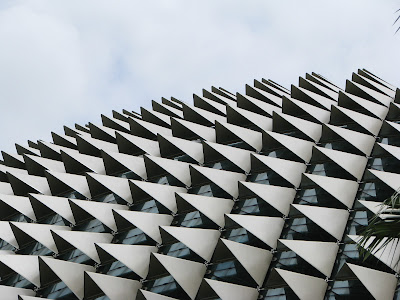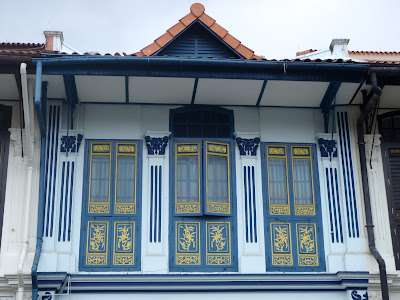For our two-week trip on the Malaysian peninsula, we started off with the island city-state of Singapore, easily accessible on a direct flight from Seoul.
The symbol of the city is the Merlion, which is half-lion and half-fish. It represents the island's maritime connections and the origin of the city-state's name - Singapura means Lion City in Sanskrit.
 |
Merlion at Collyer Quay |
Not far from Collyer Quay, on Esplanade Drive is the Esplanade Theatres on the Bay, where the roof bears a striking resemblance to a spiky durian.
 |
| Esplanade Theatres on the Bay |
 |
| roof close-up |
Later on we visited the Buddha Tooth Relic Temple, which as its name implies, houses a tooth of Buddha. Built in 2007 it is one of Singapore's newest shrines and is very opulent.
 |
| Prayer wheel |
 |
| guardian statue of the temple |
Singapore's architecture displays a range of influences from different styles and periods. Below are a few photos from different areas of the city, showing this variety.
 |
| shophouses |
Shophouses are typical in Singapore (although they can be found to a greater or lesser extent all over SE Asia). Typically a shop is on the ground floor, and accommodation is above on the first and even second floors.

 |
| note the carved swing doors |
The next day we went to Singapore zoo. I'm not normally a great fan of zoos, but I'd long heard how good this one was, and it certainly has an amazing variety of wildlife.

 |
| Proboscis Monkey |
 |
| cheetah |
Lemurs of course I know well from several trips to Madagascar and Mayotte.
 |
| Ring-tailed lemur |

As we had just entered the year of the White Tiger on February 15th it was appropriate to end our visit to the zoo by seeing one!

As we were staying in the area of Singapore known as Little India, the city's only mosque for Malabar Muslims (Muslims from the Indian state of Kerala) was not far away from our hotel.
 |
| Masjid Malabar (Malabar Mosque) with its onion dome and octagonal turret |
A little further on, near Arab Street, is the city's most important mosque which dates from 1928. An earlier mosque was built on the same site a century before.
 |
| Masjid Sultan (Sultan Mosque) |
 |
| washing, drying |
After four days in Singapore we flew to Langkawi in north-western Peninsular Malaysia for the rest of our trip.
Suggested reading:
The Rough Guide to Malaysia, Singapore & Brunei

















